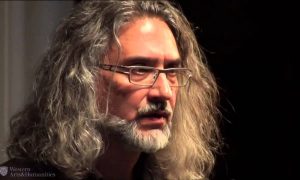Massumi, Brian. Ontopower: War, Powers, and the State of Perception. Durham NC: Duke University Press, 2015. Hardcover, Paperback, E-book, ix + 320 pages.
A veritable articulation of power after (and operating alongside) Foucault’s biopower, Ontopower: War, Powers, and the State of Perception offers a framework and conceptual tools for navigating the post-9/11 reality of the “war on terror.” Ontopower, in expressing the edges of Massumi’s philosophical frontier, is as much an incisive exposition of processes animating the U.S. military as it is a prolegomena to strategies for resisting war, capitalism, and neoliberalism. Ontopower, a positive power-to that insinuates itself into the infra-level of becoming (the as yet barely there of what will become),[1] is most potently exemplified by the military, which primes bodies to function as part-subjects of a self-correcting war-machine.
In its self-causing operation, the logic of preemption incipiently and effectively generates fear as it’s own fuel qua the virtuality of future threat. The Long War inaugurated during the Bush administration in response to the 9/11 attacks sanctioned this unending and affectively self-propelling operative logic of preemption, which itself feeds threat forward through time in an affective-driven logic of would-have/could-have done it to cast it’s shadow of fear onto the present, regardless of actual facts. While this self-causing logic of preemption unfurls as a perpetuity of fear, blurring the lines between domestic security and military action, the framework of understanding outlined in Ontopower and role of philosophizing therein suggests the possibility of ontopowerful alternatives.
In this penetrating erudition of process philosophy-meets-affect theory, Massumi synthesizes the works of Gilles Deleuze, Alfred Whitehead, William James, Michele Foucault, Baruch Spinoza, Charles Pierce, Fredrich Nietzsche, Giorgio Agamben, and a number of other scholars. He deconstructs post-9/11 military theory with a perspicacious mastery of diction in order to unveil the hidden yet immanently effective power of operative logics.
This task is not without it’s own challenges given that this kind of logic operates below the threshold of conscious awareness. However, the piecemeal organization of chapters does not help in distinguishing preemption from the broader genus of ontopowerful, transhistorical tendencies called operative logics. Though the challenge of wading through this dense thicket of profound insight calls for a familiarity with Massumi’s previous works or with some of the above mentioned authors, Ontopower equips readers with conceptual tools for identifying mechanisms of preemptive power and for evaluating events as power expressions of the singular, abstract forces (e.g. pragmatism of concepts) that govern the actual working-out of an operative logic.
Massumi organizes the text into three parts with an afterword which warrants reading twice over to digest. In “Part One:  Powers,” Massumi compares preemption to Cold War era logics of deterrence and prevention and furthermore lays out key concepts for grappling with preemption as an operative logic of power— the “universal accident,” “singular-generic,” “prototerritory,” and “bare activity,” to name a few.
Powers,” Massumi compares preemption to Cold War era logics of deterrence and prevention and furthermore lays out key concepts for grappling with preemption as an operative logic of power— the “universal accident,” “singular-generic,” “prototerritory,” and “bare activity,” to name a few.
Chapters three and four of “Part Two: Powers of Perception” develop these concepts further by describing how perception itself is weaponized and, with reference to key texts in military theory, how the U.S. war-machine evolves to operate in the complex and uncertain threat-environment of a post-9/11 reality. Chapters six and seven of “Part Three: The Power to Affect” return to the domestic front in a discussion of the ontogenetic effectiveness of the color-coded terror alert system and how threat is affectively self-causing in lieu of a “clear and present danger.”
Chapter five (listed under Part Two) and the afterward expound on the formative aspect of history in-the-making, speculating that immanent critique, to “‘observe’ what is energetically not taking place, coeval with a moment’s effective self-completion,” (208) is a task for philosophic thought. As a central thread which weaves together the pragmatic “how it works” and the speculative considerations of philosophy’s task, Massumi emphasizes a new ecology of powers in which the infra-activity of ontopower and the operative logics thereof “encompass and exceed” the other modes of power (namely, Foucault’s topology of powers: sovereign, disciplinary, and biopower).
Framing it in context with notable moments during the Bush administration, Massumi analyzes how preemption was endorsed in rhetoric and concomitant policies that called America to act at the level of life’s emergence: “to disrupt [the enemy’s] plans and confront the worst threats before they emerge.”[3] This incitatory approach to national security assumes that threat is proliferative anyway so the strategic course of action is to stir the enemy out of indeterminate potential by attacking first, getting the actual facts later.[4] “Terrorists” are taken to be the enemy in this scheme, inseparably associated with unspecified threat, and they have the advantage of surprise due to their networked, cellular organizations as opposed to the hierarchical, vertebrate structure of the state.[5]
The strategy of network-centric war was adopted to combat terrorists in this asymmetrical warfare effectively together with infra-colonizing the edge of bare activity so as to affectively in-train bodies to behave as part-subjects in a well-oiled, full-spectrum military machine. This couplet of network-centric war and taking power to the edge are explicit military theories which Massumi deconstructs with an event-logic to expose what the consequent mechanisms of preemptive power are and how they operate as processual tendencies that in turn affect modulations throughout the entire field of life.
This event-logic, which posits the subject (knower) and object (known) as co-emergent from events rather than prefigured realities, is advanced by Massumi together with affect theory in order to describe the incipient activity of operative logics. As a working definition in chapter one, operative logics “combine an ontology with an epistemology in such a way as to trace itself out as a self-propelling tendency that is not in the sway of any particular existing formation but sweeps across them all and where possible sweeps them up in its own dynamic” (5, italics from original text). In the case of preemption, indiscriminate threat, objectively unknowable until it’s potential takes an actual form, is taken both as it’s object (ontology) and as it’s self-constitutive cause (epistemology).
Preemption then orders itself ontogenetically around the uncertainty of threat (taking power to the edge at the level of emergence), making the virtuality of future threat felt in the present moment affectively as fear and, in turn, effectively poising bodies for action before it emerges. This self-renewing momentum of preemption unfurls as a life cycle of the threat-event—virtuality of future threat produces present affect of fear (effectively poising bodies for action), preemptive action catches the threat before it emerges, and actions retroactively legitimized because if it could have happened it would have, looping ad infinitum with an indefinite reach.
 An example of these threat-events is the 2003 invasion of Iraq on the premise “to disarm Iraq of weapons of mass destruction,” which were later found to be nonexistent, only to be retroactively legitimized because of the double conditional would-have/could-have: “Saddam Hussein could have had weapons of mass destruction and if he had had them, he would have used them” (13, italics from original text). The operative logic of preemption is therefore dangerously proliferative because it’s object and cause converge in the uncertainty of enemy attack, generating a self-renewing circuitry of preemptive action that is affectively driven by the virtuality of future threat (e.g. the affect of fear in present moment).
An example of these threat-events is the 2003 invasion of Iraq on the premise “to disarm Iraq of weapons of mass destruction,” which were later found to be nonexistent, only to be retroactively legitimized because of the double conditional would-have/could-have: “Saddam Hussein could have had weapons of mass destruction and if he had had them, he would have used them” (13, italics from original text). The operative logic of preemption is therefore dangerously proliferative because it’s object and cause converge in the uncertainty of enemy attack, generating a self-renewing circuitry of preemptive action that is affectively driven by the virtuality of future threat (e.g. the affect of fear in present moment).
It’s this self-causing aspect of operative logics which make them so ontopowerful and its the logic of preemption which marks an unprecedented exercise of power. Nature itself is redefined as a menacing, indiscriminate threat wherein “the overall environment of life now appears as a complex, systematic threat environment, composed of subsystems that are not only complex in their own right but are complexly interconnected” (29). With nature now appearing as a complex and uncertain threat-environment war powers telescope to the infra-level of bare activity so as to ontopowerfully leverage the indeterminate potential of threat to reemerge on less aleatory and more manageable grounds.
Acting on this level of life’s emergence—priming bodies for the next-effect of life’s becoming—leverages the conditions for what’s to come within more manageable parameters and furthermore ripples to effect modulations throughout the entire field of life (i.e. nearly all facets of life). “An environmental power that returns to life’s unlivable conditions of emergence in order to bring life back, redirecting its incipience to alter-emergent effect, is an ontopower…a power for the serial production of variations belonging to the same power curve, or tendency” (41, 221, italics from original text).
This return to life’s re-arising at the infra-level of bare activity is an exercise of taking power to the edge, modulating the serial iteration of events to unfurl within the folds of the military so that circumstances can be more effectively managed. War powers telescope to this infra-level of bare activity or the “unlivable conditions of emergence” to operationalize perception itself so that bodies constituting the war-machine are trained to operate in real-time as “nodes in a network” (chapter 4). So not only does preemption entail acting before a threat even emerges. The full-spectrum situation of preemption inaugurates a new topology of power for the war machine to achieve self-synchronization and it insidiously shores up on the domestic front in cases like over policing communities of color or immigrants, over the top security responses, and increased surveillance of citizens.
Notwithstanding how Ontopower expertly deconstructs military theory and advances a philosophical framework for understanding the immanent force of history, Massumi’s “pragmatic metaphysics” (or “radical empiricism” as he expresses with reference to William James) espoused therein fails to distinguish preemption from the broader genus of operative logics. Though he does explicitly address neoliberalism and neoconservatism as operative logics in the afterword, the affective component which propels the self-renewing momentum characteristic of operative logics is not mentioned in the discussion (nor in chapter 2 where he first mentions neoliberalism and neoconservatism).
What is the affective drive propelling the self-renewing momentum of neoliberalism and neoconservatism, if any? Given the visceral potency of fear and concomitant susceptibility of bodies to be innervated by fear (chapter 6), is it possible to have an operative logic not predicated on fear? Are there other “dispositional angles of affectivity” capable of governing alternative operative logics? Seeing as five of the chapters had been published prior to composing Ontopower (chapters 1, 2, 3, 6, and 7), it’s up to the reader to extract themes which cut across the text as a whole. Key concepts like affectivity can consequently fall through the cracks, lacking a comprehensiveness that leaves its role in operative logics (other than preemption) somewhat unclear. Although Massumi goes to great lengths in the preface and afterword to elucidate the complexity of ontopower and operative logics thereof, the piecemeal organization of the book could benefit from the addition of transitional summaries in each chapter to improve accessibility.

In bringing the subterranean operation of preemption to the surface as an immanent force in-forming the backdrop through which experience occurs, Massumi successfully enunciates the exercise of a new mode of power after biopower: ontopower. Situating preemption in an ecological field of relation with the other regimes of power (namely sovereign, disciplinary, and biopower), as an environmental power it shifts from operating on a given territory to operating in the prototerritory of emergence, e.g. the force of time. As an infra-level force which targets perception, this force-to-own-time takes bare activity as it’s object and is exercised along the full spectrum, from the civilian sphere to the battlefield.
While the fact that war powers have telescoped to this untimely interval of life’s emergence is daunting to say the least, chapter five and the afterword especially provide the conceptual tools for navigating the post-9/11 reality, identifying mechanisms of preemptive power, and evaluating transhistorical, formative tendencies as they express themselves in historical moments. After having read Ontopower determined readers will be better equipped to develop ecological approaches to political history, psychology, sociology, and a number of other disciplines. Moreover, by exposing the incipient activity of operative logics, Massumi calls attention to how these transhistorical tendencies unfold in the interval of history’s in-the-making and that with the right conceptual tools, they can be disarmed and potentially reprogrammed. As challenging as it is rewarding, Ontopower may therefore serve as a prolegomena to strategies for resisting dominate, transhistorical tendencies such as preemption, capitalism, and neoliberalism and for participating in a politics to come.
Adam Loch is a graduate student in Religious Studies at the University of Denver. In addition to the study of religions his interests include philosophy, politics, psychology, ethics, and the role of the subject in knowledge formation. As an aspiring professor, yoga instructor, and social activist, he works to redress globalizing processes from outstripping cultural and ecological difference in a joint effort of theory and praxis.
_________________________________________________________________________________________________
[1] An explanation of the prefix ‘infra-’ from Massumi’s Politics of Affect is particularly useful: “‘Infra-’ on the other hand connotes what actively lies below a certain threshold of appearance on an open-ended spectrum (as in ‘infrared’; from inferus, below). The threshold of appearance designates a turning point where the spectrum of changes qualitatively in nature, while retaining the continuity of gradations (as when infrared shades into the visible region of the spectrum, which is also the qualitative turning point where heat becomes light).” Massumi, Brian. Politics of Affect. John Wiley & Sons, 2015. 212. This infra-level of bare activity is signified by the prefix ‘onto-’ and plays a major role in Massumi’s wedding of affect theory and process philosophy together in the critical analysis of ‘War, Powers, and the State of Perception.’
[2] Massumi primarily uses two texts, Network Centric Warfare: Developing and Leveraging Information Superiority (Alberts, Garstka, and Stein 2000) and Power to the Edge: Command and Control in the Information Age (Alberts and Hayes 2003), in his analysis of the U.S. military organization’s topology of power post-9/11 (chapter 4). He also deconstructs the military doctrine of Shock and Awe (Ullman and Wade 1996) in chapter 3.
[3] Quote from George Bush in June 2002 when speaking to a graduating class of the United States Military Academy at West Point, New York. Italics from original text.
Massumi, Brian. Ontopower: War, powers, and the state of perception. Duke University Press, 2015. 3.
[4] The “war on terror” rally cry underpinning this approach did not begin nor end with the Bush administration. Rather, the 9/11 attacks belong to an iterative series of “terrorist attacks” dating back to the early 1970s and has stretched indefinitely into the future, as illustrated by Obama’s executive decision to deploy drones for extrajudicial killings, the administrations push to expand surveillance on American citizens, and the preemptive policing of protestors at the 2010 G20 summit (225-232).
[5] This “becoming-terrorist of your own” by mimicking the structure of terrorist groups is synonymous with the strategy of network-centric war and is done to effectively fight “terrorist networks”. The conceptual distinction between cellular organizations and vertebrate structures is put forward by Arjun Appadurai in Fear of Small Numbers: Cellular systems are “connected yet not vertically managed, coordinated yet remarkably independent, capable of replication without central messaging structures, hazy in their central organizational features yet crystal clear in their cellular strategies and effects, these organizations clearly rely on the crucial tools of money transfer, hidden organization, offshore havens, and nonofficial means of training and mobilization, which also characterize the workings of many levels of the capitalist world”; vertebrate systems “are not necessarily centralized or hierarchical. But they are fundamentally premised on a finite set set of coordinated, regulative norms and signals.” Appadurai, Arjun. Fear of small numbers: An essay on the geography of anger. Duke University Press, 2006. 21-31.




